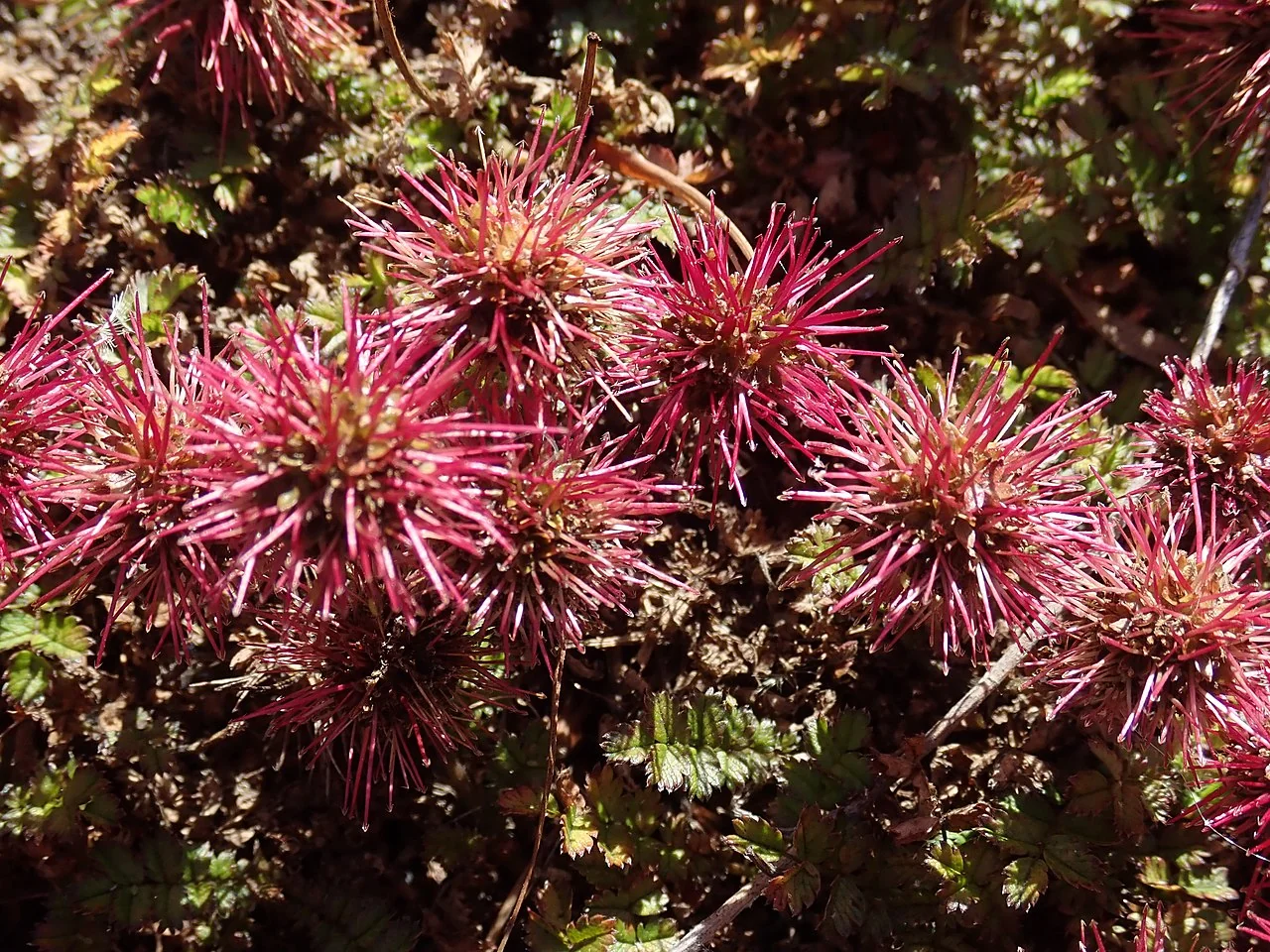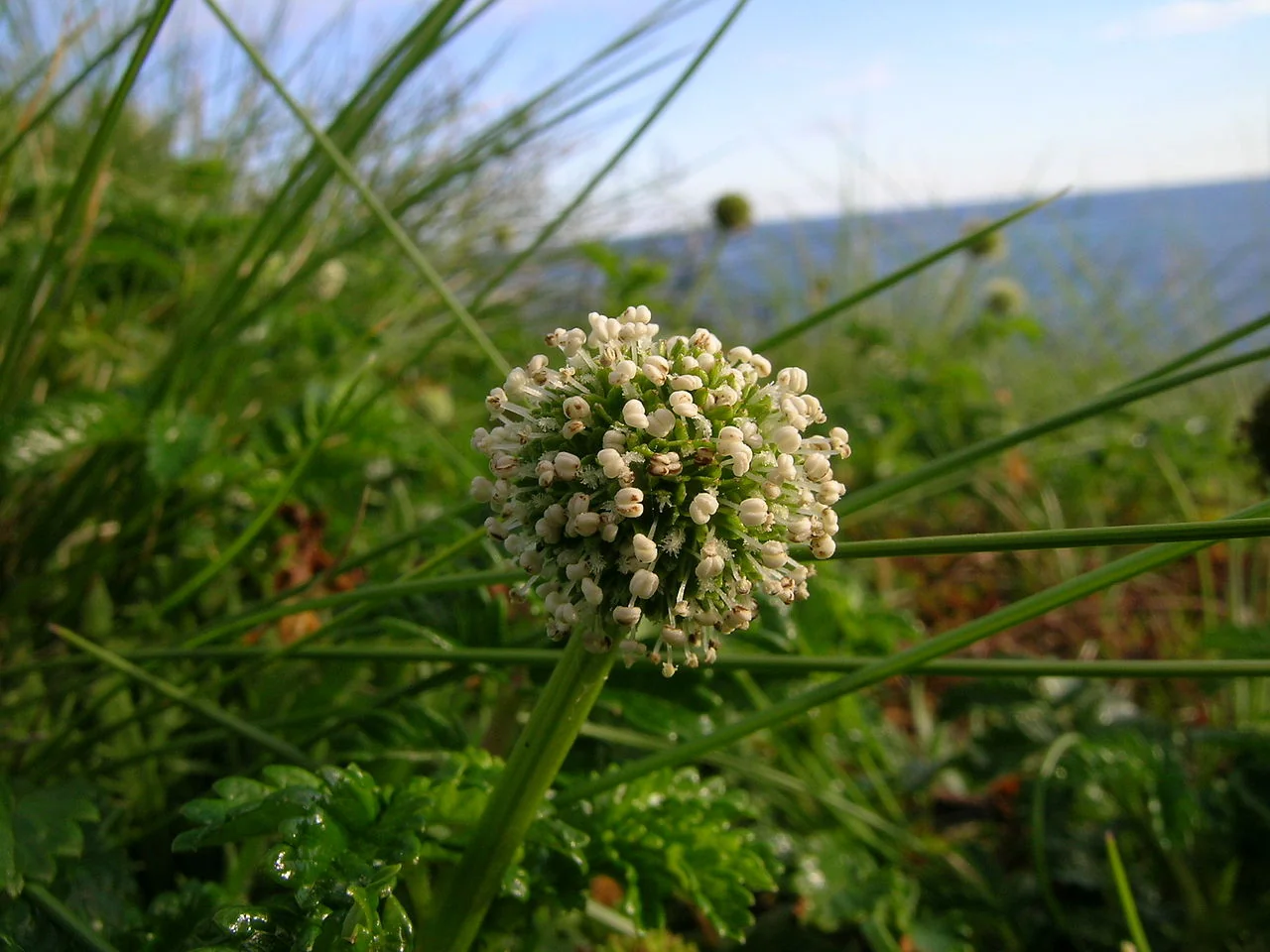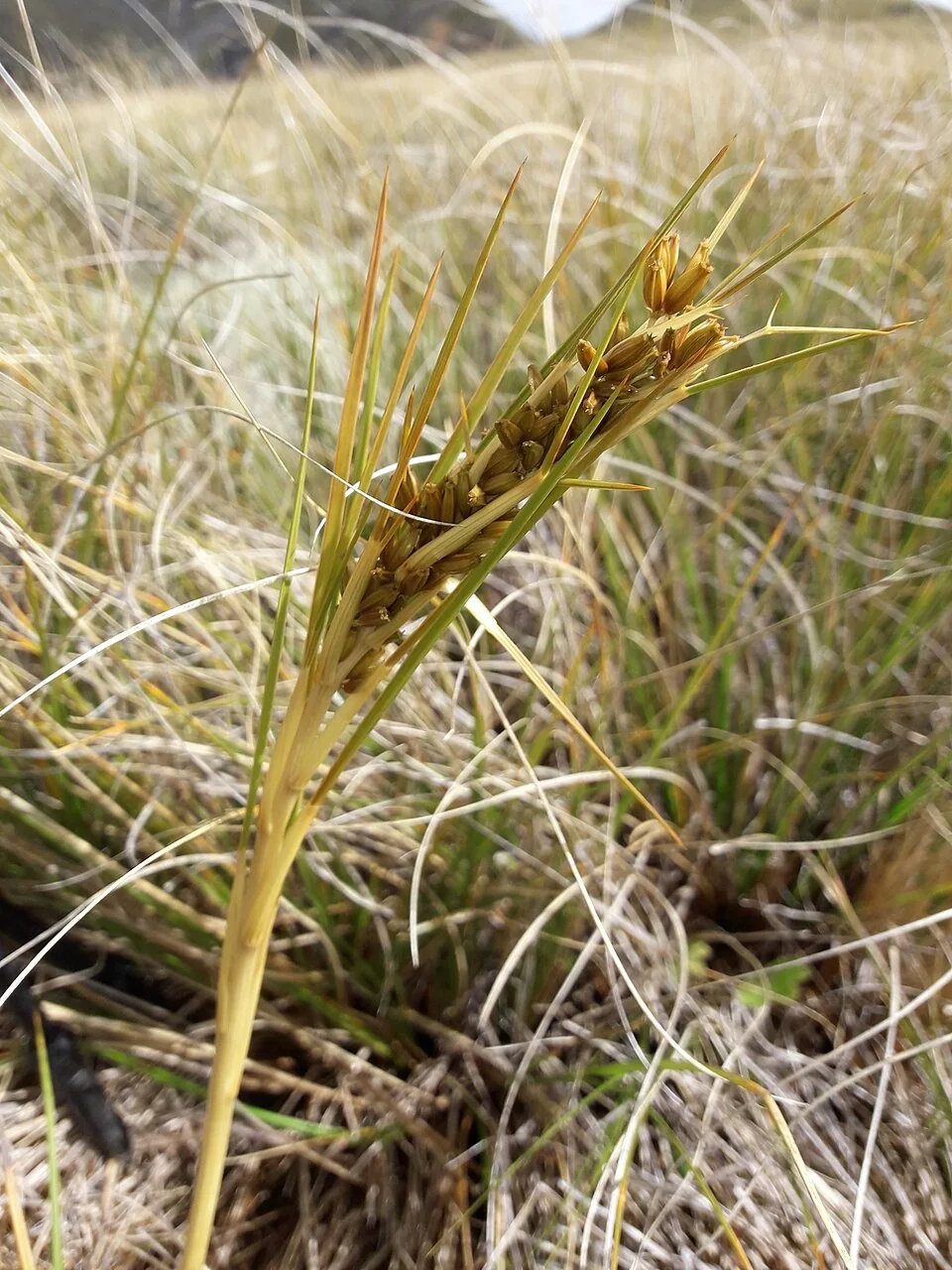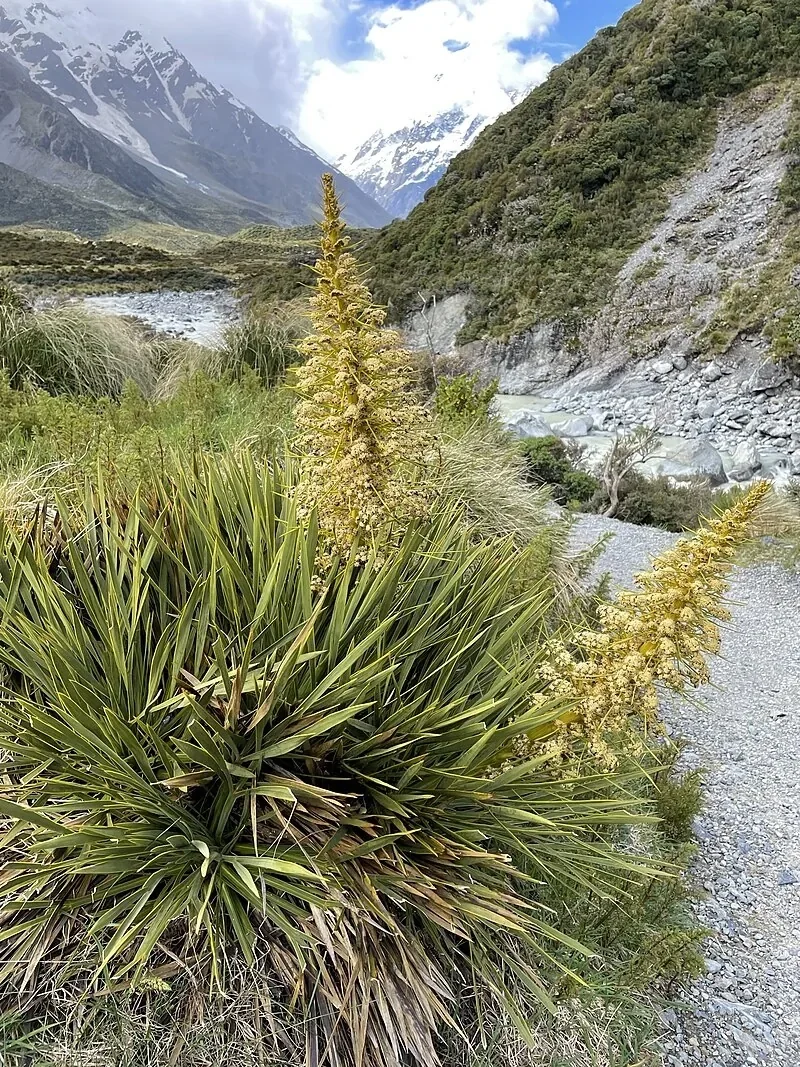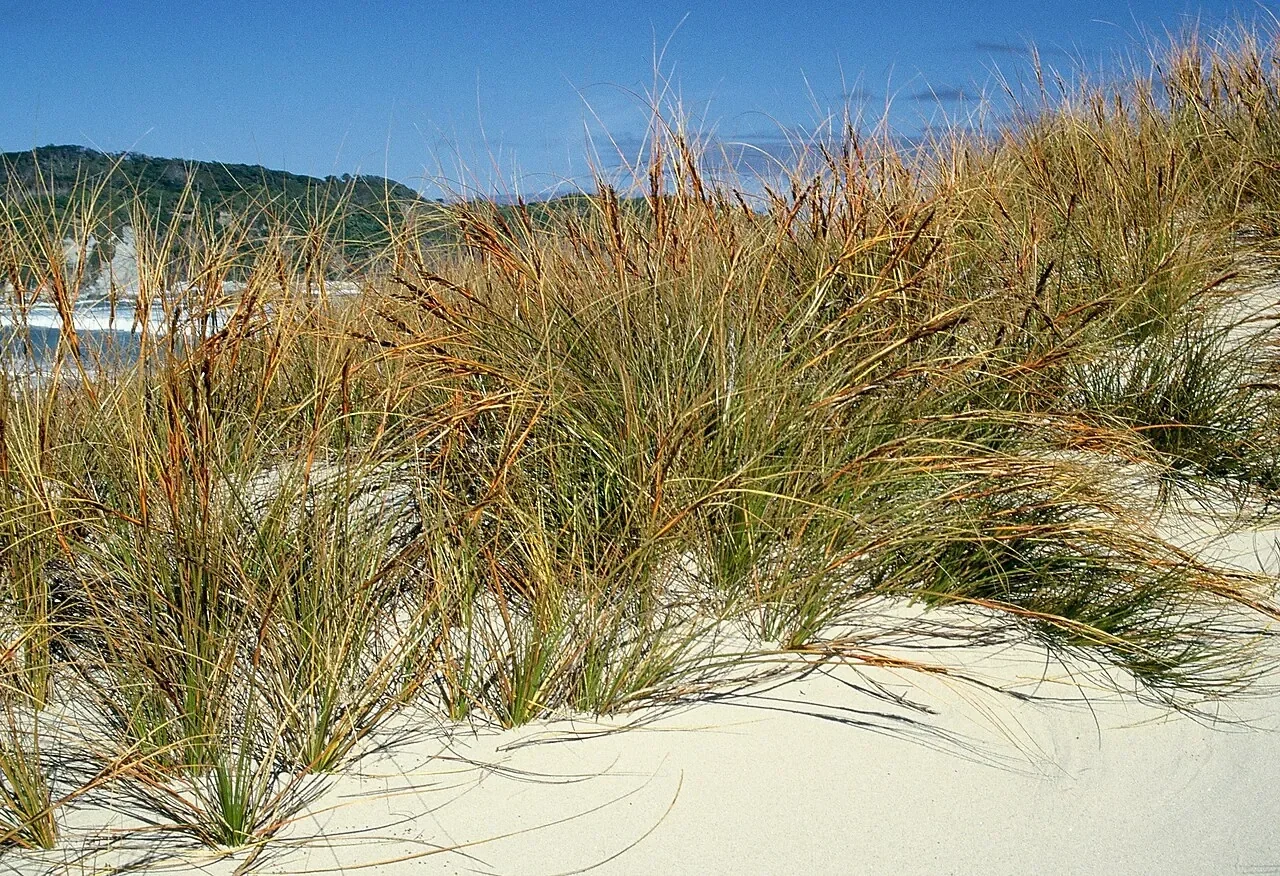
Pīngao
Ficinia spiralis
Pīngao ( Ficinia spiralis ) stands as one of New Zealand's most culturally and ecologically significant coastal plants , renowned for its distinctive golden-orange spiral seed heads and crucial role in binding sand dunes along the country's extensive coastline. This remarkable endemic sedge represents a true partnership between nature and culture, serving simultaneously as a keystone species for coastal ecosystem stability and as one of the most prized traditional weaving materials in Māori culture, where its strong, flexible golden leaves have been treasured for centuries in creating beautiful kete (baskets), whāriki (mats), and other taonga (treasures). The plant's most distinctive characteristic lies in its remarkable transformation from bright green juvenile foliage to stunning golden-orange mature leaves that spiral elegantly from thick, creeping rhizomes, creating dramatic textural displays that can be seen from considerable distances across coastal dune systems. Found naturally on active sand dunes, foredunes, and coastal margins throughout New Zealand including the Chatham Islands, Pīngao has evolved extraordinary adaptations to survive in one of the planet's most challenging environments, including deep root systems that can extend several meters to access groundwater, salt-tolerant physiology, and specialized leaf structures that minimize water loss while maximizing sand-binding efficiency. The species plays absolutely critical ecological roles in coastal protection, with its extensive root network and mat-forming growth habit creating the primary defense against coastal erosion while providing essential habitat for numerous specialized dune-dwelling insects, lizards, and ground-nesting birds. Culturally, Pīngao holds profound significance in Māori tradition, where its harvest and preparation for weaving follows ancient protocols that ensure sustainable collection while maintaining the spiritual connection between the weaver and the natural environment. In modern conservation efforts, Pīngao has become a flagship species for dune restoration projects, as its presence indicates healthy coastal ecosystems while its decline in many areas highlights the ongoing impacts of habitat modification, introduced species competition, and climate change on New Zealand's vulnerable coastal environments.

Explore more NZ native plant guides in our index .
Plant Description
Botanical Features
Ficinia spiralis , also known as Pīngao, Pīkao, or Golden Sand Sedge, is a robust, tufted sedge endemic to New Zealand, including the Chatham Islands. It typically grows between 30 to 90 cm tall and is characterized by its stout, yellow-green to golden-orange appearance, especially when dry. Its leaves are numerous, stiff, and harsh, ranging from bright green when young to golden yellow or deep orange on mature plants. They are 2-5 mm wide, linear, and have sharply denticulate (finely toothed) margins and keel. It has a stout, woody, creeping rhizome, 10-15 mm in diameter, covered by fibrous strands from decaying leaf-sheaths. The culms (stems) are numerous, 0.3-1.2 m tall, erect, obtusely trigonous (three-angled), and very leafy at the base. The inflorescence is paniculate, 70-300 mm long, composed of about 12 confluent clusters of sessile spikelets, subtended by rigid, leaf-like bracts. The seeds are shiny, dark brown, egg-shaped, 3-5 mm long, ripening and falling in early summer. It is a sand-binding sedge that produces long, prostrate, tough rope-like stolons that creep along the sand surface, helping to stabilize sandy soil.
Quick Facts
Coastal Plant Summary
| Scientific Name | Ficinia Spiralis |
|---|---|
| Common Name | Pīngao, Golden Sand Sedge |
| Family | Cyperaceae |
| Height | Up to 1 m |
| Spread | Spreading, mat-forming |
| Light | Full sun |
| Soil | Well-drained sandy soils |
| Water Needs | Low (drought-tolerant) |
| Frost Tolerance | Moderate |
| Salt Tolerance | High |
| Growth Rate | Medium |
| Lifespan | Perennial |
Climate Best Suited to
Pīngao ( Ficinia spiralis ) is naturally adapted to the harsh conditions of New Zealand's coastal sand dunes. It thrives in temperate maritime climates, tolerating strong winds, salt spray, and intense sunlight. Its extensive root system helps it to anchor firmly in unstable sandy soils, making it a vital component of dune ecosystems across both the North and South Islands. While it prefers coastal environments, it can be cultivated in inland areas provided it has excellent drainage and full sun exposure.
Regional Suitability
| City | Climate Suitability |
|---|---|
| Whangārei | Ideal |
| Auckland | Ideal |
| Hamilton | Ideal |
| Tauranga | Ideal |
| Rotorua | Ideal |
| Gisborne | Ideal |
| New Plymouth | Ideal |
| Napier | Ideal |
| Whanganui | Ideal |
| Palmerston North | Ideal |
| Wellington | Ideal |
| Nelson | Ideal |
| Christchurch | Ideal |
| Dunedin | Ideal |
| Invercargill | Ideal |
Natural Habitat
Typical Environments
Understand the natural habitat of Pīngao ( Ficinia spiralis ), which is exclusively found on coastal sand dunes throughout New Zealand. This section details its geographical distribution, preferred environmental conditions, and the types of ecosystems where it naturally occurs.
- Widespread on coastal sand dunes across the North, South, and Stewart Islands.
- Prefers exposed foredunes and mobile sand environments.
- Often found in association with other sand-binding plants like Spinifex.
- Thrives in full sun, high wind, and salt-spray conditions.
Its presence is a strong indicator of a healthy, functioning dune system, and understanding its habitat is crucial for successful restoration efforts.
Plant Conservation
Ficinia spiralis , commonly known as Pīngao or golden sand sedge, is a coastal sedge endemic to New Zealand. Its conservation status is generally classified as "At Risk - Declining." While some sources indicate it is "Not Threatened," they also highlight significant pressures on the species.
The conservation status can vary regionally within New Zealand. For instance, in Otago, it was classified as "Threatened - Regionally Critical" in 2024, and in Auckland, it is considered "At Risk - Regionally Declining" as of 2025.
Key Threats to Ficinia spiralis
- Competition from introduced species such as marram grass (Ammophila arenaria) and Pinus radiata.
- Habitat loss and modification.
- Dune stabilization and compaction.
- Trampling and vehicle traffic.
- Browsing by animals like rabbits and possums.
Despite these challenges, Pīngao is culturally significant for Māori communities and plays a vital ecological role in dune stabilization. It is protected in certain areas and is actively used in restoration efforts by community groups and the Department of Conservation.
Growing Requirements
Soil Requirements
Pīngao thrives in very well-drained, sandy soils, mimicking its natural dune habitat. It is highly tolerant of nutrient-poor conditions and does not require rich soil. Good drainage is paramount to prevent root rot, as it is accustomed to rapidly draining coastal sands. Avoid heavy clay soils or areas prone to waterlogging.
- Prefers sandy, free-draining soils.
- Tolerates nutrient-poor conditions.
- Requires excellent drainage; susceptible to root rot in wet soils.
- pH adaptable, but generally prefers slightly acidic to neutral.
Light Requirements
Full sun exposure is essential for Pīngao to develop its characteristic golden-orange colour and robust growth habit. While it can tolerate very light shade, its vigour and colour will be significantly reduced. Plant in an open, exposed site where it receives direct sunlight for most of the day.
- Requires full sun for optimal growth and colour.
- Tolerates light shade, but growth may be less vigorous.
- Prefers open, exposed positions.
Water Requirements
Pīngao is highly drought-tolerant once established, requiring minimal supplemental watering. During its establishment phase (first 6-12 months), regular watering is beneficial to encourage a strong root system. After establishment, it can withstand long dry periods, making it an excellent choice for low-maintenance coastal gardens.
- Drought-tolerant once established.
- Water regularly during establishment.
- Avoid overwatering, especially in non-sandy soils.
Planting Guide
Best Time to Plant
The best time to plant Pīngao is during autumn or spring, when temperatures are mild and rainfall is more consistent. This allows the plant to establish its extensive root system before the extremes of summer heat or winter cold.
Choosing a Location
Select a site with full sun and extremely well-drained sandy soil. Pīngao is ideal for coastal areas, sand dunes, or any garden with poor, sandy soil where other plants struggle. It can also be grown in large containers with appropriate sandy potting mix.
Planting Steps
- Dig a hole twice the width of the root ball and the same depth.
- Gently remove the plant from its container, being careful not to disturb the roots.
- Place the plant in the hole, ensuring the top of the root ball is level with the surrounding soil.
- Backfill with sandy soil, firming gently around the base of the plant.
- Water thoroughly immediately after planting to settle the soil.
- Do not mulch heavily, as Pīngao prefers open, sandy conditions.
Initial Care
Water regularly during the first 6-12 months to help establish a strong root system. Once established, Pīngao is very low maintenance and requires little to no supplemental watering. Protect young plants from severe wind erosion if planted in very exposed sites.
Ecological Role
Ecosystem Roles
The ecological importance of Pīngao ( Ficinia spiralis ) within New Zealand's coastal ecosystems is paramount. As a primary sand-binding plant, it plays a critical role in the formation and stabilization of sand dunes, which are vital natural barriers against erosion and storm surges.
- Primary sand-binding species, crucial for dune formation and stability.
- Creates microhabitats for other coastal flora and fauna.
- Contributes to the overall biodiversity and health of dune ecosystems.
- Provides shelter and food for specialized coastal invertebrates and lizards.
Its extensive root system helps to trap and accumulate sand, building up dunes and protecting inland areas. This makes Pīngao an indispensable species in coastal restoration and conservation efforts across the country.
Uses and Significance
Garden Uses
- Essential for sand dune stabilization and erosion control.
- Excellent for coastal gardens and exposed sites.
- Adds unique texture and golden colour to landscapes.
- Suitable for mass planting in restoration projects.
- Low maintenance once established.
Landscaping Applications
Pīngao ( Ficinia spiralis ) is an excellent choice for landscaping in coastal and exposed environments, offering both aesthetic appeal and practical benefits. Its distinctive golden foliage and architectural form make it a striking feature in native gardens, while its hardiness and sand-binding capabilities are invaluable for erosion control.
- Ideal for coastal gardens, dune plantings, and erosion control.
- Creates a natural, windswept aesthetic.
- Can be used in mass plantings for dramatic effect.
- Suitable for low-maintenance, drought-tolerant landscapes.
When designing with Pīngao, consider its natural mat-forming habit and allow it space to spread. It pairs well with other coastal native plants, creating a resilient and ecologically rich garden.
Seasonal Care Calendar
Spring
New growth emerges, and this is an ideal time for planting new Pīngao specimens. Ensure consistent moisture for young plants and protect them from strong winds if necessary. Light fertilization with a slow-release native plant fertilizer can encourage vigorous growth.
- Ideal time for planting.
- Ensure consistent moisture for new plants.
- Light fertilization if needed.
Summer
Pīngao is actively growing and may produce flower spikes. Established plants are drought-tolerant, but young plants may require occasional watering during prolonged dry spells. Monitor for any signs of stress from extreme heat or lack of water.
- Active growth and flowering.
- Water young plants during dry periods.
- Monitor for heat stress.
Autumn
Growth slows as temperatures cool. This is another good time for planting, allowing roots to establish before winter. Collect seeds from mature plants for propagation. Minimal care is required for established plants.
- Good time for planting.
- Collect seeds for propagation.
- Minimal care for established plants.
Winter
Pīngao is largely dormant during winter. It is moderately frost-tolerant, but in very cold regions, young plants may benefit from some protection. Ensure good drainage to prevent root issues in wet conditions.
- Dormant period.
- Protect young plants from severe frost.
- Ensure good drainage.
When to Prune and How Much
Pīngao generally requires minimal pruning. The primary reason for pruning is to remove dead or damaged leaves, or to tidy up the plant's appearance. Avoid heavy pruning, as this can stress the plant.
- Remove dead or yellowing leaves as needed.
- Light trimming to maintain shape.
- Avoid heavy pruning.
- Use clean, sharp tools.
For traditional Māori weaving, leaves are harvested sustainably, ensuring the plant's health and continued growth. If growing for weaving, consult with local iwi (tribe) or experienced weavers for best practices.
How to Grow Pīngao
Pīngao, also known as Golden Sand Sedge, is an iconic and culturally significant native plant, crucial for stabilizing sand dunes and enhancing coastal ecosystems. Its distinctive golden-orange, spiraling leaves and robust nature make it an excellent choice for coastal gardens, dune restoration projects, and any landscape requiring a hardy, salt-tolerant plant. While it thrives in challenging environments, understanding its propagation methods is key to successfully growing this specialized species and contributing to its conservation.
From Seed
Propagating Pīngao from fresh seed is a viable method, though germination can be slow and erratic, requiring patience. Collect ripe seeds from mature plants in late summer to autumn. Clean the seeds thoroughly to remove any fleshy material. Sow the seeds in a tray filled with sandy seed-raising mix, lightly covering them. Maintain consistent moisture in the seed mix and keep it in a warm, sheltered location. Germination can take several months, and sometimes longer, so do not discard trays prematurely. Once seedlings are large enough to handle, typically after developing a few true leaves, they can be carefully transplanted into individual pots and grown in a sheltered environment before planting out into their final coastal position.
From Division
Division is a simpler and often more reliable method for propagating established Pīngao clumps, particularly in spring when new growth is emerging. Carefully dig up a mature clump, or a section of it, using a sharp spade. Gently separate the clump into smaller sections, ensuring each division has a healthy portion of roots and some foliage. Replant the divisions immediately into well-prepared sandy soil, ensuring they are planted at the same depth as the original plant. Water thoroughly after planting and keep consistently moist until established. This method is excellent for quickly expanding your stock of plants and for rejuvenating older, less vigorous clumps, while maintaining the genetic characteristics of the parent plant.
Pests and Diseases
Pīngao is a remarkably hardy plant and generally resistant to most pests and diseases. Its adaptation to harsh coastal environments means it has few natural enemies.
Common Pests
- Generally pest-free.
- Occasionally, mealybugs or scale insects may appear, but rarely cause significant damage.
Common Diseases
- Highly resistant to diseases.
- Root rot can occur in poorly drained, waterlogged soils.
Maintaining excellent drainage is the best preventative measure against any potential issues. Healthy, well-sited plants are rarely affected by pests or diseases.
Cultural Significance
Ficinia spiralis , commonly known as Pīngao, holds significant cultural importance, particularly within Māori traditions in New Zealand. It is considered a taonga (treasure) species due to its practical uses, spiritual significance, and ecological role.
Key Aspects of Cultural Significance Include:
- Traditional Weaving Material: Pīngao leaves, which turn a bright yellow when dried, were highly prized by Māori for weaving. They were used to create a variety of items such as hats (pōtae), bags (kete), mats (whāriki), headbands, belts, and raincapes.
- Decorative Art: The plant's fibers were also incorporated into decorative tukutuku panels found in wharenui (Māori meeting houses).
- Spiritual and Mythological Importance: Pīngao features in traditional Māori stories and art forms, reflecting its spiritual significance. One legend describes the spirits of the dead carrying Pīngao along the pathway to the underworld, dropping it to mark their journey back to Hawaiki. Another tale links its origin to a battle between the gods Tangaroa (lord of the ocean) and Tāne (lord of the forest).
- Other Practical Uses: Historically, South Island Māori fashioned body armor from Pīngao leaves for battle. The tender growing tips of the plant were also a traditional Māori food.
- Ecological and Conservation Value: Beyond its cultural uses, Pīngao is an endemic sand-binding plant vital for stabilizing coastal dunes and preventing erosion, creating habitats for native wildlife. Its decline due to introduced species and other factors has both cultural and ecological significance, leading to ongoing conservation and restoration efforts.
- Contemporary Relevance: Pīngao remains important in contemporary Māori culture and environmental stewardship, symbolizing a connection to traditional landscapes and practices.
Bonus Tip
Expert Growing Advice
Pīngao ( Ficinia spiralis ) is a true marvel of coastal engineering! This unique sedge is endemic to New Zealand and plays a crucial role in stabilizing sand dunes. Its long, tough, rope-like stolons creep along the sand surface, effectively binding the sand as they get buried. What's more, its leaves transform from bright green to a stunning golden-orange as they mature, creating a distinctive hue that makes patches of Pīngao easily recognizable from a distance. This vibrant colour also made it a highly prized material for traditional Māori weaving, adding beautiful golden highlights to kete (baskets) and whāriki (mats).




